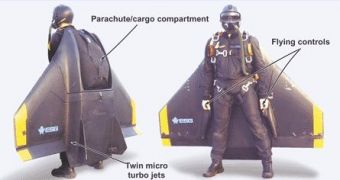The gamers probably remember the famous "Jet Pack" from the old Command & Conquer: Red Alert series or even from the childish (is it?) Worms game. For those who don't, let me tell you that the jet pack is a concept dating from World War II, when Germany made late-war experiments of strapping two wearable shortened Schmidt pulse jet tubes of low thrust to the body of a pilot. The working principle was the same as the Schmidt-Argus pulse jet that powered the Fieseler Fi 103 flying bomb whereas the size was much smaller.
The device was called "Himmelst?rmer" (Skystormer) and operated as follows: when the flier ignited both engines simultaneously the tubes began to pulse modulate. The angled rear tube strapped to the flier's back provided both lift and forward thrust while the chest mounted deflector tube of lower thrust maintained a constant upward thrust. This lifted the flier up and forward. By opening the throttle to the rear tube, calculated "jumps" could be made of up to 60 meter (180 ft) at low altitude (under 50 ft, 15 m). The tubes consumed very little fuel but not much could be carried either.
Now, the German electronics and technology companies ESG and Dr?ger (not surprised?), which originally developed an unpowered version for the German army, presented a reinvented format that addresses military paratroopers.
It's called Gryphon Single Man Flying Wing and it's a combination between a parachute system equipped with a 1.5m (4.9ft)-span delta wing and two micro-turbojets which could propel a paratrooper 200km (110nm) from a drop point.
It almost looks like a small plane, or UAV, and it has ailerons and flap-like control surfaces like normal aircrafts. It has flexible containers in its leading edge with a capacity of 2 liters (0.5 Usgal) of jet fuel. To control it, the parachutist, or paratrooper, will use handles linked to servomechanisms.
So far, it sounds great, and if Michael Jackson used a jet pack to fly off the stage at one of his concerts, why couldn't paratroopers do it too?
The concept was designed in a wind tunnel, with extreme attention to the aerodynamics, so the engines are likely to be built into the wing, which also has a cargo compartment, and the actual parachute will sit in an opening big enough to accommodate it without causing any drag.
The turbojets are expected to weigh around 7kg (15.4lb) each and could be model aircraft engines, industrial impellers or a new design. The wing system will weigh approximately 30kg (65lb) with engines but no cargo.
Manufacturers claim that a parachutist could jump from up to 33,000ft (11 km) using the system, with oxygen equipment and thermal clothing. On reaching an altitude of 3,000-5,000ft (1000-1500 meters), the parachute is opened and the wing lowered on a cord to hang several meters below the user.
It sure sounds promising, though I'm not sure they took into account the fact that a military rucksack filled with mission-vital equipment weighs about 30 kg (65lb) by itself, not to mention the standard Colt M4A1 Carbine. There's no sign of it in the picture, I wonder where did they shove it?

 14 DAY TRIAL //
14 DAY TRIAL //